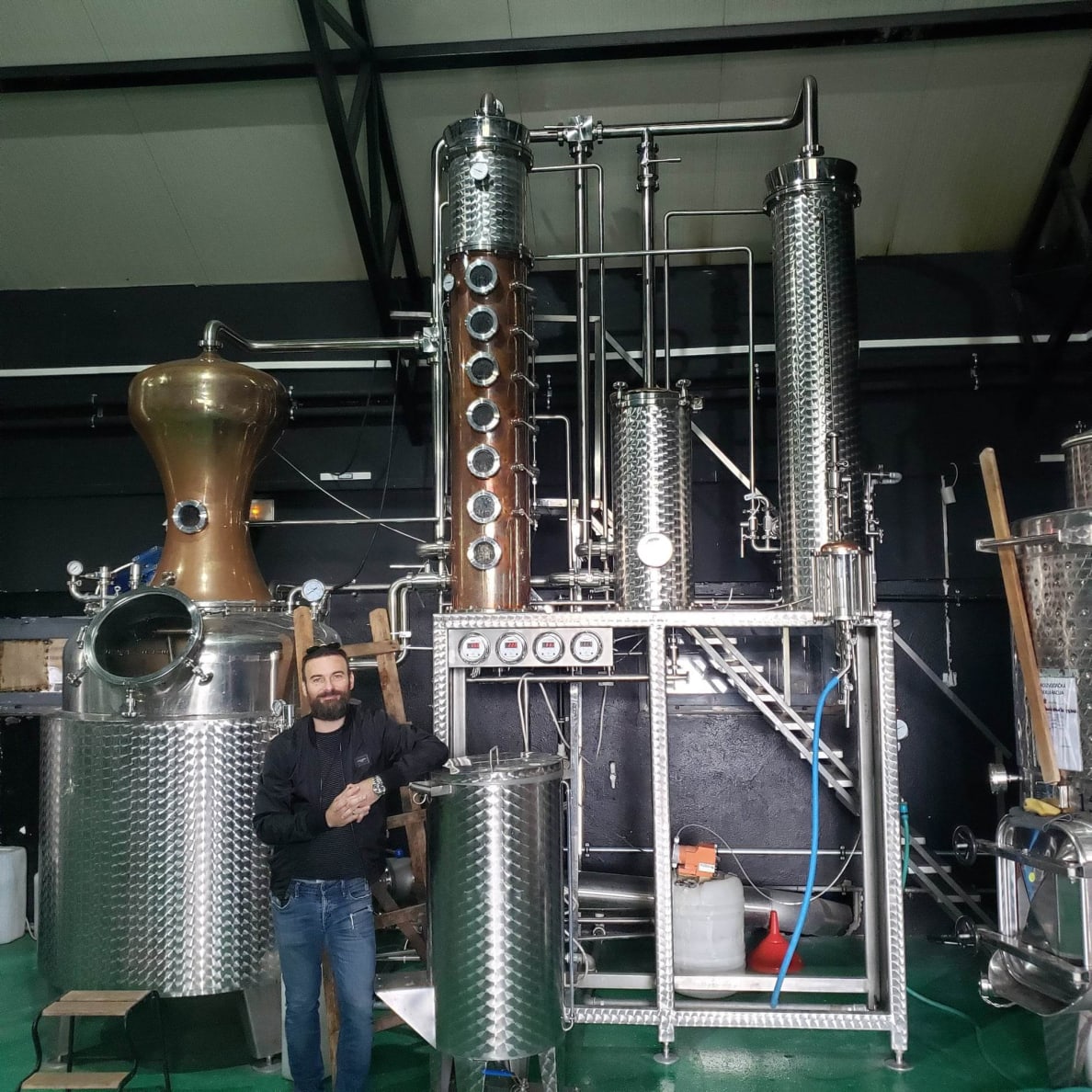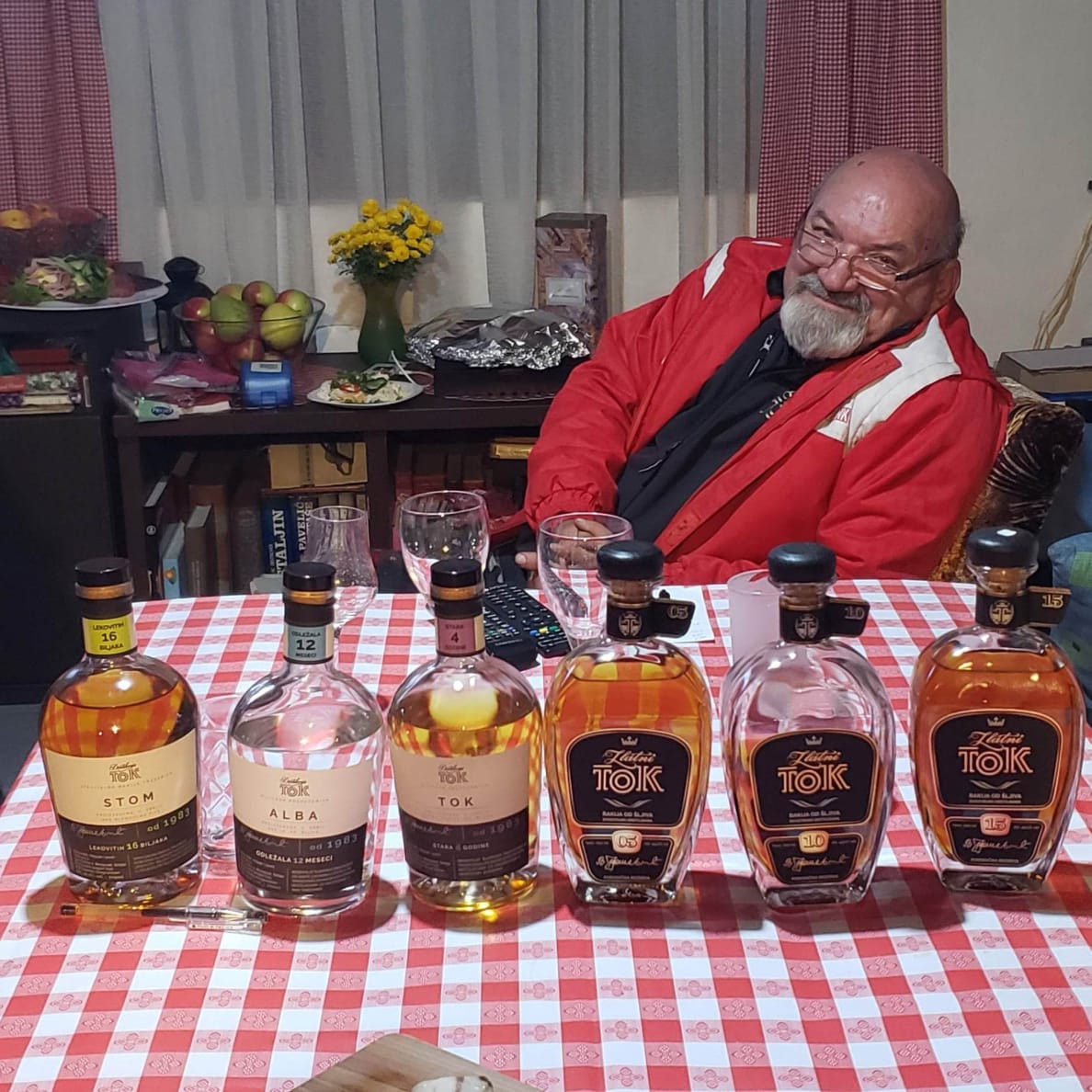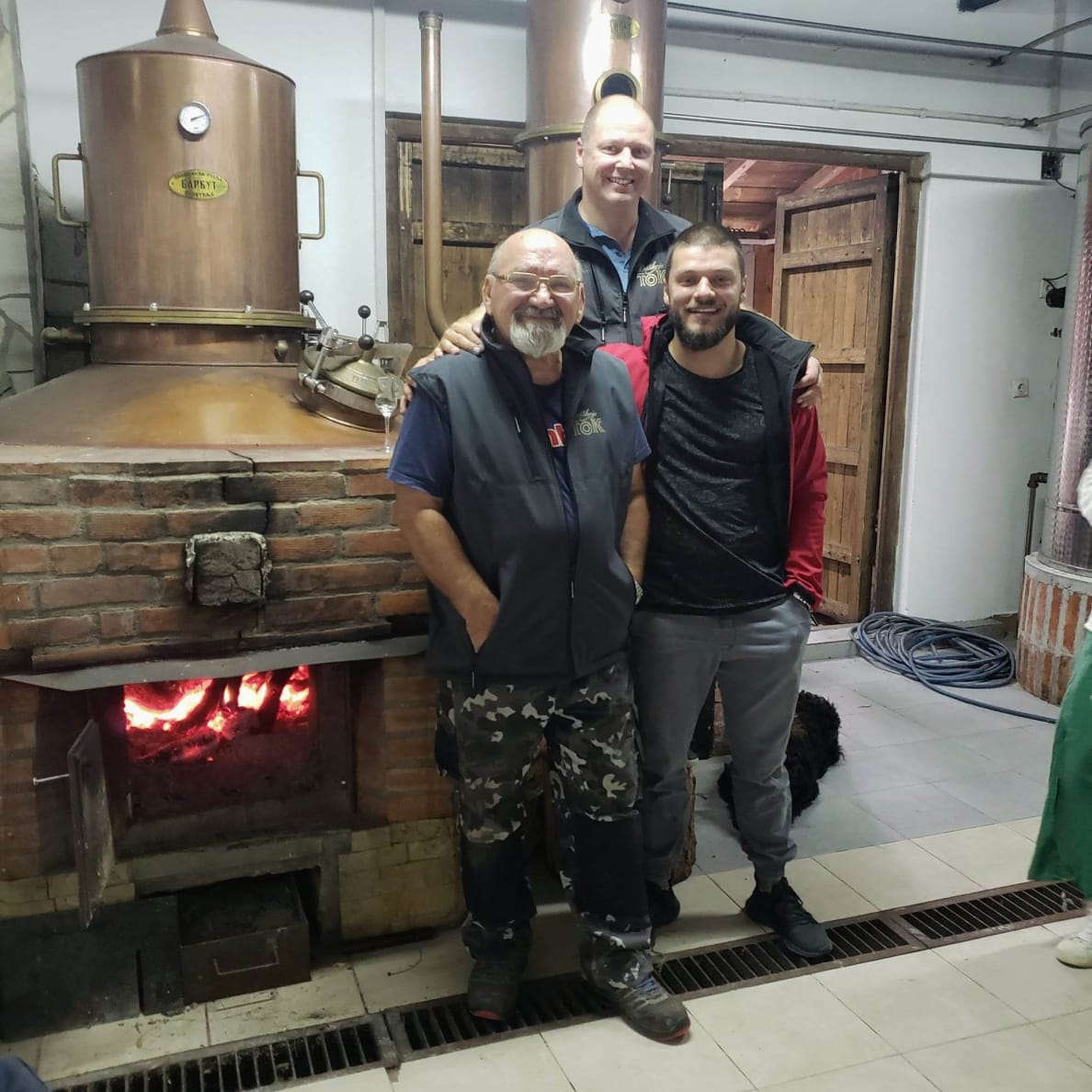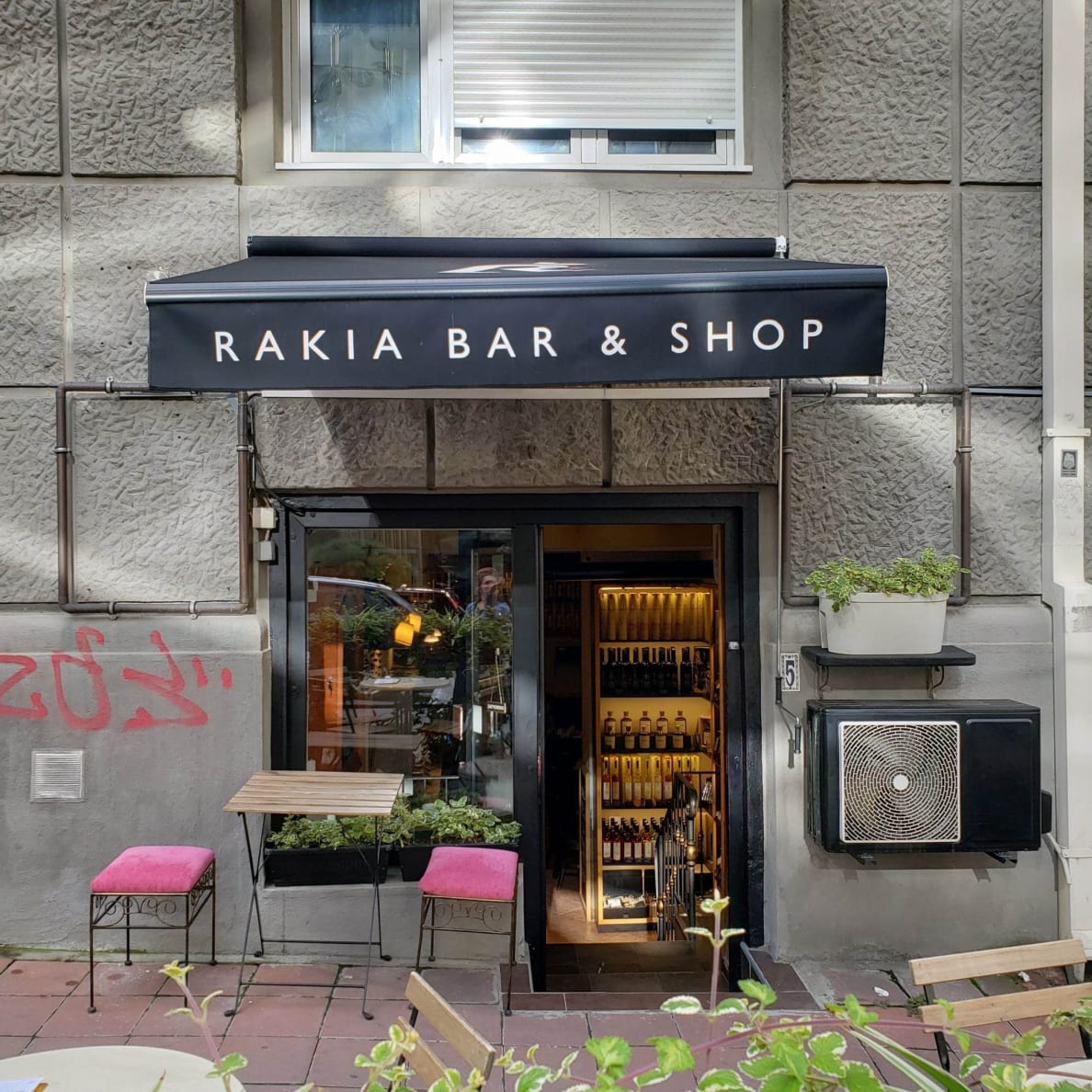The Rakija Museum is only 15 miles from the center of Belgrade, but it can take an hour to get there if your taxi driver hasn’t been there before. It’s up a network of roads that are so narrow and hilly and unmarked that at some points, Google Maps can’t even be bothered. Occasionally you’ll pass a tractor or a fruit stand, but for the most part, the landscape looks the same as it did 100 years ago.
The taxi driver can be forgiven, though. Locals don’t really need to go to the Rakija Museum. Spend a few days in Belgrade and it feels like the whole city is a rakija museum. From fine dining restaurants to cocktail bars to kafanas, the Balkan answer to the pub, you can try a variety of the native fruit brandy.(This is a good moment to note that brandy is any alcohol distilled from fruit, so Cognac, Armagnac, Pisco, and applejack all fall under the classification.)
Sljivovica, the most common rakija, is distilled from plums, one of Serbia’s main exports, and it’s so integral to the local culture that in December it was inscribed on UNESCO’s List of Intangible Cultural Heritage. But rakija can also be made from quince, pear, apricot, apple, or even grapes. Ask anyone about it—young or old—and they’ll tell you about the person (typically a grandfather or uncle) in their family who makes it on an improvised still in their kitchen. And probably about how another family member (typically a grandmother) administered tiny amounts of it to them as a child to treat everything from cuts to colds. These days, however, a generation that watched a grandparent or uncle casually cook up šljiva at home is fine-tuning the recipe and turning the age-old craft into a modern business. Quality rakija is easier than ever to find on the shelves throughout Serbia today. And it’s starting to arrive in the U.S., too
Dejan Momcilovic, the museum’s director, greeted me when I finally arrived. He wasn’t bothered that I was 40 minutes late to our appointment. As I would quickly learn over the few weeks I spent in Belgrade this fall, it’s rare for anyone to be upset if you’re late. Serbians have famously perfected the art of sitting around and talking—be it over coffee, tea, burek (think: spanakopita, but with a lot of meat), charcuterie, or rakija. And if you’re late, the only one who loses out is you.
Rakija is distilled and drunk throughout the Balkans, but most experts—and, of course, Serbians—agree that it originated in Serbia, where it’s been made since at least the 15th century. That’s the museum’s claim, too. Among many vintage bottles, it features the original 1909 patent for a rakija still, the first patent ever awarded by the newly opened patent office of the nation, which was then known as the Kingdom of Serbs, Croats and Slovenes. Dejan catalogs international politicians and notables who’ve been spotted with the spirit. He’s particularly keen on sharing how the Serbian prime minister gifted a bottle to Bill Gates when he was in Belgrade to plan a Microsoft office.
The museum is also the site of a distillery that’s been producing Bojkovcanka since 1985. It was an early entrant on the growing premium commercial rakija market, Dejan led me to a wood table in a courtyard and poured a few varieties—tart quince, jammy apricot, and vibrant plum, each a vivid, pure expression of its fruit. The heat of the alcohol wasn’t an interference as much as a mere reminder to take it in slowly.
Rakija is to Serbia what pisco is to Peru and what rum is to the Caribbean, which is to say: ubiquitous. For generations it was known as a peasant drink and much of the commercial products were mass produced and evoked moonshine. But with the growth of awareness of the rich heritage of native spirits around the world, Serbians realized they were sitting on a sleeping giant. And instead of shelling out on pricey tequila, Scotch or American bourbon, a younger generation turned to parents and grandparents to discover more about the heritage that they’d long looked past as they cast their gaze the the rest of the world.
My formal introduction happened around 35,000 feet above the Atlantic. On a direct Air Serbia flight from New York’s John F. Kennedy’s International Airport to Belgrade’s Nikola Tesla Airport I had the choice of five rakijas—plum, quince, apricot, Williams pear, and honey. I ordered the plum, or šljivovica. As he poured it, the flight attendant asked if it was my first time trying rakija. Yes, I said. It won’t be my last, he assured me. Proudly. His uncle, he went on, made šljivovica and would drop off plastic bottles full of it the first weekend of every month. He smiled as if speaking about an old friend, a tone that becomes the default when people reminisce about the drink, which is often conflated with reminiscences of childhood.
In Belgrade, you don’t find rakija. It finds you. At the bar at The Square, a fancy modern restaurant in the posh Square 9 Hotel, I tried four different rakijas—most memorably a floral muscat and an angular cuvee—each custom made for Square 9 at a farm about 40 miles away. The bartender walked me through a tasting as he would if he were offering high-end single malt Scotch. At a lively night market, amid vendors selling handmade soaps, sweaters, jams and jewelry, I met Nikola Stojnic, who makes wine and rakija at this vineyard 23 miles from Belgrade. He and his father manned a table displayed with bottles of grape, quince, and apricot rakijas. They were pouring samples of apricot in tiny plastic cups and offered me one. Then before long, a third. The language barrier was intense, but the rakija was gentle, aromatic and vivid. “The best!” one of them said, pointing to the medals on display. And at Townhouse 27, a stylish boutique hotel that was my homebase, Kristina, a blond woman in her twenties who helmed the front desk, told me about her father, a police inspector who lives in a village in North Serbia and makes šljivovica on a still in his backyard with plums his uncle grows. Next time I’m in Belgrade, she’ll bring me some. It’s the best, she assured.
Cocktail bars are in on it, too. At Riddle Bar, a handsome den with art nouveau flourishes and a steady soundtrack of ice clanking around in shakers, it was a rakija-spiked Manhattan and several riffs on a negroni. And on the cobblestone street outside, a wood stall housed a table arranged with glass vessels of rakija—apricot, quince, walnut, raspberry. A young woman in a purple denim jacket dispensed them through a spigot. Club-goers in miniskirts shimmied by and forked over cash for shots in tiny plastic cups.

But no matter how many different rakijas I tasted in Belgrade,it took a trip to the countryside to truly understand why the drink is so important here.. A local friend and I arranged to meet Emina Vidosavljevic, a guide from City Tourist Organization of Kragujevac, Serbia’s fourth-largest city, located 95 miles south of Belgrade in Šumadija, a region named for its forested (šuma) landscape. She took us on a šljivovic-fueled spree across the region. Stari Hrast, a bucolic winery with vast vineyards, produces rakija that we tried in a stone-walled tasting room, where the snacks come courtesy of a septuagenarian who lives down the street and uses her generations-old recipe for the pickled veggies. At Pevac Cellar, a young restaurant-industry veteran in a black Dolce & Gabbana bomber jacket showed us around his distillery, a sleek building with huge windows that has a nightclub-like appearance on approach and a Brooklyn loft-like vibe at the bar inside, what with rustic wood tables and velvet couches. If I needed any proof that a new generation of rakija producers was among us, this was it.
The beating heart of the region is in the mountains of Goč. Pine tree forests are dense on both sides of the dirt road that leads to Destilerya Tok. This is Ljuba Urošević’s turf, and people make pilgrimages here to seek advice from the Jedi-master-like figure, who can taste šljivovic and identify the type of plum it’s distilled from and even the region where it’s made. Ljuba spent decades as chief technical officer at what was the biggest distillery in the former Yugoslavia. Now retired, he built this mountain-set sanctuary distillery in part as a hobby and in part for his sons, Jovan, 27, and Ivan, 43, to carry on his legacy.
“Ljuba is like some kind of living legend. When he retired, he came to Goc and now people travel here to ask him questions. Professors call on him to make presentations,” Jovan told me. “He has incredible knowledge of production and aging, but it’s not in his nature to brag. He’s really a lone wolf.”
The family only uses plums they harvest from the nearly 3,000 trees on their property, and only once they’ve ripened enough that they’ve fallen from trees, guaranteeing the highest sugar content and aromatic compounds, the peak moment for fermentation. (“He taught us how to collect at a very early age, when all of our classmates were on holiday,” said Ivan, noting that Ljuba grew up on the property and started gathering the fruit when he was 6.)

Distiller Ljuba Urošević.
Liza Weisstuch
Ljuba, who looks like Hemingway’s good-humored Balkan cousin, showed us his still, which he heats by open flame fueled by wood that he and his sons chop. Then he led us to his “office” (a gazebo) because the fresh air is best for tasting, and gazed across a valley to where Ljuba grew up. The mountain has its own microclimate, thanks to the pine oil that permeates the air and influences the plums as they grow. The pine note in the šljva is slight, but unambiguous.
The simple tour and tasting I had planned for my visit that Tuesday in October turned into a night-long bacchanal in a kitchen-equipped cozy cabin across the path from the distillery. Lillian, the family’s matriarch, brought out course after course. We were interrupted by a visit from Igor, a local forest ranger and bear of a man who arrived with a tray piled high with wild boar prosciutto and deer-thigh sausage, both made from animals he hunted. As the night got later, the rakijas got older. Ljuba trotted out a šljivovica aged 10 years, then one aged 15 years, then finally a 20-year-old, each more honeyed and raisin-y and with a fuller sense of itself than the last.
Ljuba and his sons also make Yebiga, a šljivovica they developed for Bill Gould, who was on tour in Europe with his band, Faith No More, in the 1990s when he fell in love with the stuff. Frustrated with not being able to buy quality šljiva in the U.S., he founded his own to import. It’s currently sold in eight sates and online. In recent years, he has taken part in the harvest at Tok, learning from Ljuba just as Jovan and Ivan have.

The Urošević family at Destilerya Tok.
Liza Weisstuch
“Spending time in Belgrade and seeing young people interested in what their grandfathers were making blew my mind,” Bill told me. “I was having more and more discussions about rakija’s origin and terroir. It’s ready for international prime time.”
Bill met Jovan through tasting events with Ilija Malović and Zoran Radoman, college friends who both teach high school in Belgrade. As they observed the renaissance of heritage spirits around the world—bourbon, mezcal, cachaca—they realized rakija is of similar cultural importance and poised for an artisanal awakening.
“Not long ago, you’d do an image search for ‘rakija’ and all you’d see is toothless people and moonshine production in the mountains. But there is so much beautiful spirit being made. We need to change that image and do something about how it was presented,” Zoran told me. “It deserves better. Rakija is ready for the world.”
In 2008, they created a blog, Rakija, Mostly, traveled to distilleries around Serbia and wrote about them, creating what’s arguably the biggest modern rakija resource. They recently published a book. Bigger rakija champions may not exist.

I met the pair at Belgrade Urban Distillery, a hip destination in Dorćol, an artsy neighborhood known for its bars and cafés. It’s in a cavernous old warehouse updated with colorful walls and antique lighting. Barrels are everywhere. Ilija and Zoran suggested meeting here so they could introduce me to Branko Nešić, the founder and distiller who, Ilija said, was the first to make rakija accessible and intriguing to a younger generation. He is a rakija crusader of the highest order. He opened Rakia Bar, his shop/bar, in 2006 in the basement of his grandfather’s apartment. The next year, he organized a festival, then competitions. He opened franchises of the store in Canada and Hong Kong. The distillery launched in 2016. Fifteen years ago, Branko said, the rakija industry was a “wild west.” While there are still countless home-distillers around Serbia, there is a growing structure, which is helping it make its way to other parts of the world.
Rakia Bar sells over 150 rakijas, all from small producers, including BUD. It also offers coffee paired with Branko’s bright, aromatic šljiva, a play on the Serbian tradition of drinking coffee with sweet fruit jam on toast.
“In Yugoslavian times, big amounts of ‘Big Rakija’ was produced. Now it’s about craft. Now is the perfect time if you’re looking for small-batch spirit. The market has no place for amateurs,” Branko told me. “I expect that between five and 10 years from now, we’ll have distilleries that are competitive on the European market. Rakia Bar is heritage, the future is Belgrade Urban Distillery.”
from Hacker News https://ift.tt/W85u9Ms
No comments:
Post a Comment
Note: Only a member of this blog may post a comment.